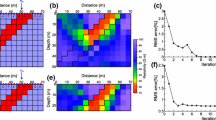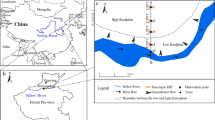Abstract
Five intersecting resistivity sections have been measured in glaciofluvial deposits hosting an aquifer of regional importance situated along a heavy traffic highway in Sweden. The winter salt spreading has caused a regular salinity increase through the years. For imaging the transport of saltwater in the aquifer, the sections were measured exactly in the same location before and after winter, and interpreted using a time-lapse inverse procedure. Some auger drilling and RCPT data were available for correlation. After winter, the resistivity had generally decreased under the water table and increased above it. The decrease in resistivity in the saturated zone is interpreted as a plume of more saline groundwater created by de-icing salt from the road. The increase in the upper layer can be explained by changes in temperature and soil moisture. The study shows that time-lapse resistivity investigations has potential for imaging hydraulic pathways in complex hydrogeological environments.










Similar content being viewed by others
References
Aaltonen J (2001) Seasonal resistivity variations in some different swedish soils. Eur J Environ Eng Geophys 6:33–45
Acworth I, Dasey G (2001) Electrical imaging of a tidal creek using combined land and underwater electrodes – an example from Hat Head, NSW, Australia. In: Proceedings of the 7th EEGS meeting, Birmingham, pp 192–193
Archie GE (1942) The electrical resistivity log as an aid in determining some reservoirs characteristics. Trans Am Inst Min Metal And Petr Eng 146:54–62
Barker RD (1990) Investigation of groundwater salinity by geophysical methods. In: Ward SH (ed) Geotechnical and environmental geophysics, vol II. Society of Exploration Geophysicists, Tulsa, OK, pp 201–211
Bruch H (2000) Bergaåsen vid Hallsjö, utredning om vägarnas och trafikens påverkan på grundvattnet, Mark&Vatten Ingeniörena AB, commissioned by the technical services of the Växjö District. (In Swedish)
Chambers JE, Loke MH, Ogilvy RD, Meldrum PI (2004) Noninvasive monitoring of DNAPL migration through a saturated porous medium using electrical impedance tomography. J Contam Hydrol 68:1–22
Chinh PD (2000) Electrical properties of sedimentary rocks having interconnected water-saturated pore spaces. Geophysics 65(4):1093–1097
Daniel CR, Campanella RG, Howie JA, Giacheti HL (2003) Specific depth cone resistivity measurements to determine soil engineering properties. J Environ Eng Geophys 8(1):15–22
Farquharson CG, Oldenburg DW (1998) Non-linear inversion using general measures of data misfit and model structure. Geophys J Int 134:213–227
Giao PH (2003) A comparative study of different electric imaging configurations in investigations of a fresh-saline water interface. In: Proceedings of the 9th EEGS meeting, Prague, pp 0–079
Loke MH (1996–2004) Manual for Res2Dinv, available at http://www.geoelectrical.com
Loke MH (1999) Time-lapse resistivity imaging inversion. In: Proceedings of the 5th EEGS meeting, Budapest, Hungary, 6–9 September, Em1
Loke MH, Acworth I, Dahlin T (2003) A comparison of smooth and blocky inversion methods in 3D electrical imaging surveys. Eplor Geophys 34(3):182–187
Mark&Vatten AB (2000) Technical report “Bergaåsen vid Hallsjö, utredning om vägarnas och trafikens påverkan på grundvattnet” (11 pages + maps, in Swedish)
Ogilvy R, Meldrum P, Chambers J, Williams G (2002) The use of 3D electrical resistivity tomography to characterise waste and leachate distribution within a closed landfill. Thriplow UK JEEG 7(1):11–18
Rein A, Hoffmann R, Dietrich P (2004) Influence of natural time-dependent variations of electrical conductivity on DC resistivity measurements. J Hydrol 285:215–232
Rosqvist H, Dahlin T, Fourie A, Röhrs L, Bengtsson A, Larsson M (2003) Mapping of leachate plumes at two landfill sites in South Africa using geoelectrical imaging techniques. In: Proceedings Sardinia 2003, 9th international waste management and landfill symposium, S. Margherita di Pula, Cagliari, Italy, 6–10 October 2003
Sen PN, Goode PA, Sibbit A (1988) Electrical conduction in clay bearing sandstones at low and high salinities. J Appl Phys 63(10):4832–4840
SEPA (1999) (Swedish Environmental Protection Agency) Environmental quality criteria groundwater, report 5051
Slater LD, Sandberg SK (2000) Resistivity and induced polarization monitoring of salt transport under natural hydraulic gradients. Geophysics 65(2):408–420
Slater L, Binley AM, Daily W, Johnson R (2000) Cross-hole electrical imaging of a controlled saline tracer injection. J Appl Geophys 44:85–102
Taylor S, Barker R (2002) Resistivity of partially saturated Triassic sandstone. Geophys Prospect 50:603–613
Thunqvist EL Johansson (2003) Estimating chloride concentration in surface water and groundwater due to deicing salt application. Ph. D. thesis, Kungl. Tekniska Högskola, Stockholm
Vägverket Konsult (2001) Väg E4 – Bergaåsen-vattenskydd. Teknisk utredning (April 2001), report No. 732063. (in Swedish), Vägverket region Sydöst, Jönköping
Ward (1990) Resistivity and induced polarization methods. In: Investigations in geophysics No. 5: Geotechnical and Environmental Geophysics, volume I: review and tutorial, Society of Exploration Geophysicists, pp 147–189
Waxman MH, Smits LJM (1968) Electrical conductivities in oil-bearing shaly sands. Trans Soc Pet Eng 243:107–115
Acknowledgements
We thank Scandiaconsult, the Road Administration of Sweden and Mark och Vatten Ingenjörerna AB for sharing information with us and allowing us to use their results. We would like to thank particularly Jörgen Brorsson (Ramböll-Scandiaconsult), Agne Gunnarson (Swedish Road Administration), Lars-Göran Svensson (BGV-Konsult) and Hans Bruch (Mark & Vatten Ingenjörerna AB). Anna-Karin Jönsson helped in gathering drilling information for the site. Virginie Leroux was partly financed by a European Commission Marie Curie grant, contract number N°EVK1-CT-2000-50004.
Author information
Authors and Affiliations
Corresponding author
Rights and permissions
About this article
Cite this article
Leroux, V., Dahlin, T. Time-lapse resistivity investigations for imaging saltwater transport in glaciofluvial deposits. Environ Geol 49, 347–358 (2006). https://doi.org/10.1007/s00254-005-0070-7
Received:
Accepted:
Published:
Issue Date:
DOI: https://doi.org/10.1007/s00254-005-0070-7




